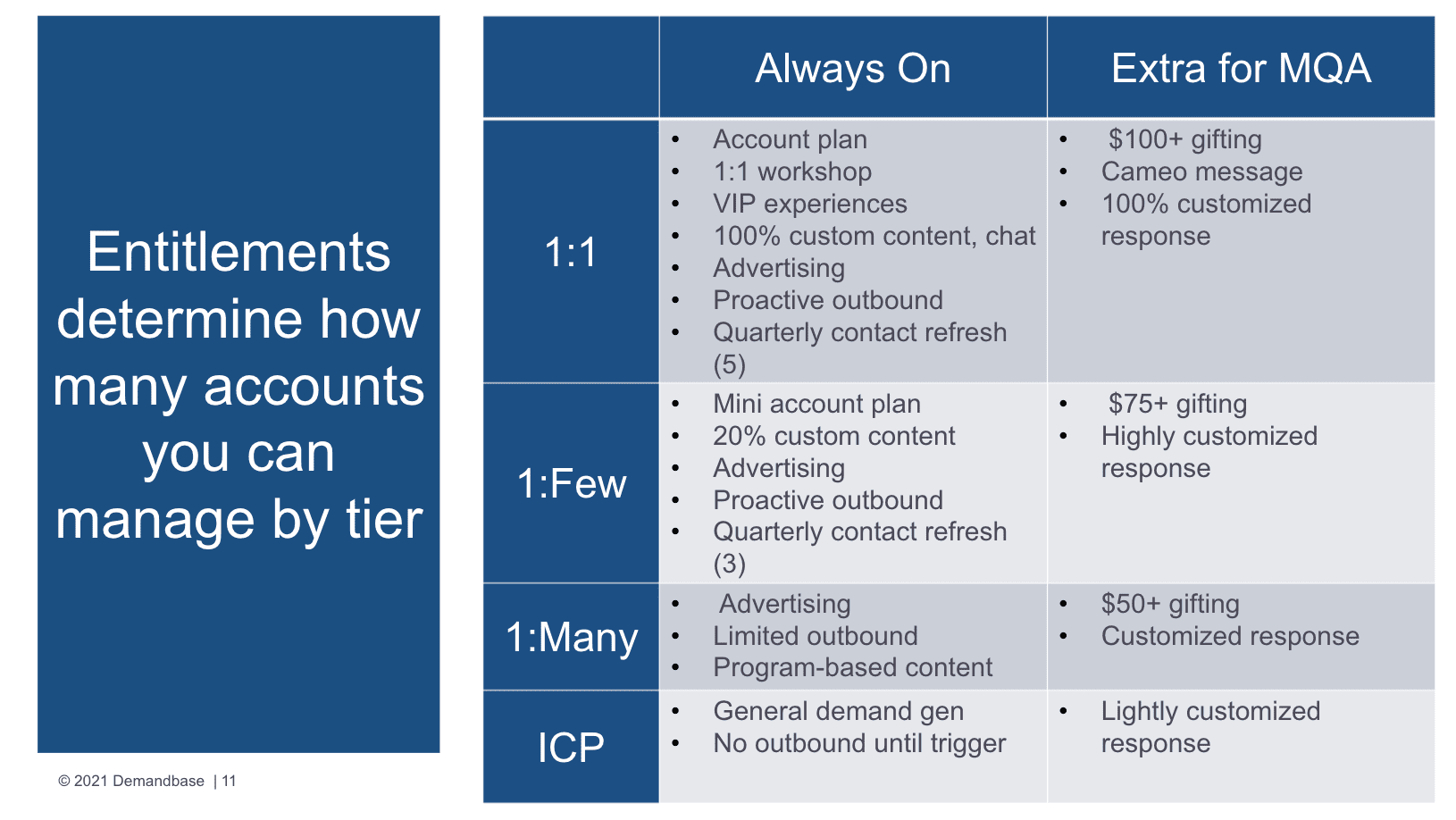Ever since account-based marketing (ABM) became a shiny object, everyone wants in on the action. For good reason; 76% of companies see higher ROI with ABM than with other types of marketing. Yet only 13% have reached maturity with ABM, according to ITSMA.
Regardless of where you are in your ABM journey, you’ve probably come to realize that it’s not just a program or a tactic; some would say that it’s not even an isolated strategy. Instead, it’s good marketing overall. It’s the best way to focus your efforts and surround accounts in an increasingly noisy B2B market.
When I joined Demandbase in 2015 as the head of demand gen, I became part of a marketing team that was already executing ABM at scale, using its own technology. We used to call it ‘drinking our own champagne’. I learned a lot in those heady days, yet I still feel like there’s a world of ABM knowledge for me to absorb. That’s why I love surrounding myself with experts like Lisa Sharapata, VP of Marketing at MindTickle, and Jon Miller, CMO of Demandbase.
Big thanks to Lisa and Jon who joined me at our recent community event to share their ABM insights, which you can take in via the session recording and/or slides.
Is ABM the Right Strategy for Your Company and Stage?
Although the ABM groundswell developed over the past several years, sellers have been surrounding key accounts for decades. They’ve long understood that closing complex, high annual contract value (ACV) deals at large enterprises requires reaching and engaging multiple buyers with a sustained effort.
Before ABM got its name, sales and marketing teams would come together to execute what we now call 1:1 ABM (vs 1:Few and 1:Many). It was a curated approach that involved account planning, high-touch treatment strategies such as VIP events, and personalized outbound programming.
I’m sure seasoned sales execs have been doing a collective eye roll since ABM became mainstream because, from their point of view, ABM is old news (sellers, do you consider yourselves the OG of ABM?). But there are now various forms of ABM that have brought sales and marketing together in a more powerful way than ever before. In fact, I love that Jon has evolved the name to ABX to acknowledge that our goal is to create an account-based experience throughout the full customer lifecycle.
As much as we all want to feel the magic of the ABM pixie dust, it’s worth taking a moment to ask yourself whether it’s the right strategy for you.
When ABM Fits, When It Doesn’t
- Defined TAM – ABM requires engagement and personalization with target accounts, so doing it well requires focus. Think thousands of accounts tops, such as enterprises in key verticals, vs tens or hundreds of thousands of accounts. The latter situation is most appropriate for traditional lead gen.
- Multiple stakeholders – Lisa hit on this critical point in her opening slide, noting how ABM fits well in complex environments with a lot of influencers in various roles to surround. ABM is particularly effective for reaching senior decision-makers who may be difficult to engage with content offers such as ebooks.
- Lower velocity sales motion – Because of the high-touch, personalized nature of ABM, it works best in environments with a longer, non-transactional sales cycle where marketing can educate the audience with content appropriate for each stage of the buyer’s journey. In this scenario, ACV and lifetime value (LTV) will tend to be higher as well.
- Internal readiness – Because of the growing popularity of ABM, there’s a temptation to purchase a solution right away to demonstrate that you’ve checked the box. Too often I’ve seen companies fail with this approach and the solution becomes underutilized; or worse, the sales team and executives conclude that ABM isn’t a fit for your business. It’s critical to first establish alignment at all levels of the organization and agree that you’re going to shift away from a volume-based leads model to ABM, even with a hybrid approach. It’s also important to agree on your metrics and KPIs and unify sales and marketing on the same set of goals. In sum, start with alignment and strategy, follow with a solution.
Once you decide to pursue an ABM strategy, it’s important to identify which style you want to adopt to match your go-to-market strategy and ACVs for key segments. Will it be 1:1, 1:Few or 1:Many? There’s no one right style, but it’s important to understand when to apply each. Most companies take a hybrid approach where, for example, they use 1:1 to bring in whale deals in their enterprise segment, while using 1:Few to engage mid-market accounts and 1:Many for SMB. Hear Jon explain the differences starting at 13:12 in the recording.
Getting Sales to Trust Intent Data
For those of you that have been doing B2B marketing for a while, like me, you understand the value of intent data. Whether we realized it or not, we actually developed rudimentary intent data from the time we launched our first form on a landing page. If a lead fit our ideal customer profile (ICP) and took the time to read our ebooks, then bingo, they were deemed to have intent by our lead scoring model and passed to sales for follow-up. This was a breakthrough at the time because we lacked other options, but we quickly realized that driving results with complex B2B sales motions — where the buyer’s journey is long and involves multiple stakeholders — requires a more holistic account view.
Intent Data Helps Us Create an Ideal Customer Experience
We know that buyers today prefer a self-directed education journey. They want to engage with sales much later than they ever did before. So, if we consider an ebook download as an intent signal for sales readiness, how do we know whether that buyer is at the beginning, middle, or end of their journey? We don’t. And that’s a problem. If we’re too early, that ruins the customer experience. And if we’re too late, we lose the deal to a competitor. (Learn more about the dangers of a transactional, MQL mindset in my blog The New Rules of Digital Advertising.)
Intent data today is more sophisticated. We can key off a variety of predictive behaviors, such as what websites our prospects or customers are visiting, what competitors they are looking at, what keywords or subjects they are searching for, and more. This gives us an indication not only of interest but of their stage in the buyer’s journey. Better still, we can know our accounts in a deeper way and use that information to improve segmentation and create a meaningful experience that resonates with our target audience. This is something Lisa talks about at 7:34 in the session recording and Jon delves into at 29:40.
MQAs convert to pipeline at a rate of 6x over non-MQAs
But as Lisa pointed out, intent data is not perfect. (And let’s hope it never becomes flawless, lest marketers everywhere face underemployment.) The point is that it’s much more effective than lead scoring, as proven by her data. Lisa shared that her MQAs (Marketing Qualified Accounts) convert to pipeline at a rate 6x greater than non-MQAs. This “A/B test” has helped her gain the confidence of her sales team because the question becomes: if we don’t trust the intent data, what other options do we have? If the results show that intent data outperforms lead scoring, that’s your answer until you have something better.
The Importance of a Blended Account Selection Strategy
That being said, I think part of gaining the confidence of the sales team is giving them a voice in the process. The “machine” does great things, but it can’t replace the value of human knowledge of your target accounts. That’s why I recommend a blended strategy for account selection. During my four years at Demandbase, we went through various iterations of account selection, from hand-picked lists, to using predictive solutions like Lattice Engines, to eventually using our own intent data (once it became available) within the Demandbase platform. We measured the effectiveness of each approach in driving pipeline, meaning the proportion of accounts that converted to pipeline within a fixed period of time.
Not surprisingly, the list selected with intent data performed the best, which gave us confidence not only in our product, but in our ability to drive the business more effectively. Still, we believed that sales could add value to the process with their human touch and pursued a hybrid account selection strategy. I was heartened to hear from Jon during his section that Demandbase still uses this approach, which he articulated as FIRE. He also emphasized the value of intent data beyond target account list selection because it provides an indication of when sales should pay closer attention to certain accounts over others. Hear more on this starting at 15:58 of the session recording.
The FIRE Methodology for Account Selection
Fit – accounts in your ICP
Intent – interest in your products and/or competitors
Relationship – context and history with the account
Engagement – time spent with your company
The Number of Accounts You Target Depends on Several Factors
One of the questions I get asked most often when I engage with portfolio companies that are kicking off an ABM strategy is, “What’s the right number of accounts to target?” As a starting point, I like to share a TAL (Target Account List) Calculator, like this one from Demandbase. It takes inputs such as the number of sales reps, quota per rep, average deal size, and so on, then spits out a number of accounts to target for your business. The caveat here is that this should serve as an indicator of where you’ll land, rather than the final number. That’s because there are several things to take into account as you determine the right number.
Maturity Stage with ABM
Most important is to consider where you are in your ABM journey. If you’re early, it’s better to start small while you learn to operationalize ABM and measure results. You want to set yourself up for success and enable the marketing team to dedicate precious resources to targeting the list. There’s no need to spread the peanut butter too thinly at the get-go. It’s not like you will ignore other accounts; it’s more a matter of where you will focus. And even on a good day, about 75% of bookings will come from TAL, so you can’t focus exclusively on the list anyway.
Size of Your TAM
The size of the possible universe is a key factor in determining list size. Obviously, the TAL has to be smaller than the number of accounts you could possibly sell to; a lot smaller, depending on conversion rates. If you sell into SMB or mid-market, your TAM is likely to be on the large side since there are always more small accounts in the universe than large. In any case, I still suggest starting small when it comes to list size, showing success, and then fanning out from there.
Entitlements
One of the most important themes in Jon’s talk track was the idea that success with ABM comes from relevance. Meaning, you have to focus your efforts to maximize personalization and impact with the accounts you’re chasing. As he said, the number of accounts you could be going after is always more than what you actually should go after.
Tactically speaking, this is your opportunity to sit down with sales and determine what treatment strategies, or entitlements, you’re going to deliver to accounts in various tiers. And the tiering system you select depends on your ACVs. For example, a small number of Enterprise accounts that are expected to yield deals valued at $2M would get the proverbial royal treatment in a 1:1 ABM motion, while dozens of mid-market accounts yielding smaller deals would receive a less bespoke, yet still personalized experience. Hear more from Jon on this starting at 12:30 in the recording and take inspiration from this chart below that represents Demandbase’s entitlements.

Getting Deeper – More Opportunities to Learn
Jon and Lisa covered a lot of ground in the session, so don’t stop here. Catch the session recording here, and take a copy of the slides. So many questions still to answer and I’m already keen to plan our next ABM session. What ABM topics would you like to hear? I’d love to hear your burning questions so we can curate the most useful insights. Let’s connect via LinkedIn to keep the conversation going.
Lisa Ames is Norwest’s CMO and Operating Executive. She leverages her more than 20 years of B2B SaaS marketing experience working shoulder-to-shoulder with portfolio companies to help them thrive.


